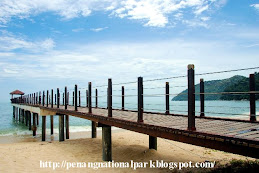There are many trekking trails; some are very remote found along the ridges. They are not well used and they were previously marked by the former Forestry Department. New markings have been put up by the present authority, namely the Wildlife Department. Since the transfer of authority to the Wildlife Department, many new changes were being developed. Below were the trails used during the expedition in 2000. Trail 1 runs along the coast from Teluk Bahang until Teluk Duyung passing through Pasir Pandak, Sungai Tukun, Tanjung Pandang, Teluk Aling, Tanjung Duyong, Teluk Duyong and ending at Muka Head. It was subdivided into 5 sectors, namely Trails 1A till 1E Trail 2 is the trail starting from Teluk Duyong cutting across the valley to Teluk Ketapang. Trail 3 is the ridge trail and the longest trail in the park that transverses from the north to the south ending at Kampung Pantai Acheh. It was subdivided into Trails 3A till 3I. Trail 4 is the trail that branch out from between 3A and 3B. It passes to the highest peak in the north at Bukit Telaga Batu and slope down to the coast in the west. Trail 5 is a short trail branching from trails 1B and 1C to join trail 6A. Trail 6 leads from Teluk Bahang to Pantai Kerachut cutting Trail 3B and 3C at the highest point of the route. Trail 7 starts from the back of the flats at Teluk Bahang to join the ridge trail at 3C and 3D. Trail 8 centres around Tanjung Kerachut. It joins trail 6 at Pantai Kerachut and trail 9 that joins to trail 10 and ending at the ridge trail. Trail 9 starts from trail 6D and 6E at Pantai Kerachut and going south ward on another ridge that late curves south west to Tanjung Kalok between Teluk Kampi and Pantai Mas. Trail 10 is the shortest trail in the park that join the two ridge trails of 9 and 3. Trail 11 is from the United Hokkein Cemetery going uphill and cutting trail 3 and descend to Pantai Mas. Trail 12 branches off from trail 3G and 3I and runs north east to United Hokkien Cemetery. Trail 13 branches off between trail 3F and 3G and runs down to Pantai Mas and Tanjung Gemeroh. Trail 14 branches off between trail 3H and 3I and runs down to join trail 15B and 15A. Trail 15 is the coastal trail from Pantai Acheh to Pantai Mas.
-------
Answer to comment by Peter:
1. To enter PNP you need a permit. Pls ask the officer in charge of the permit.
2. The trail to Ketapang is overgrown and difficult to find. Unless you are adventurous enough, I would suggest you stay away from that route.



